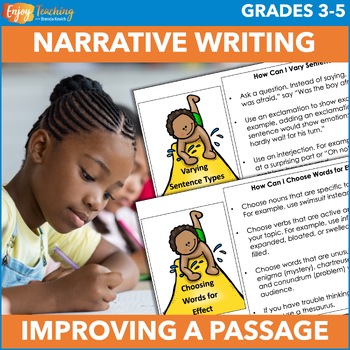Improve Narrative Writing – Practice Specific Strategies with a Passage
- PDF
- Easel Activity
Description
Improve narrative writing with focused activities and a passage. Third, fourth, or fifth grade students revise a simple story using eight strategy cards: varying sentence beginnings, varying sentence types, varying sentence lengths, choosing words for effect, using sensory language, using active verbs, adding details, and using transition terms.
Open the preview to take a closer look. You can use this activity for independent practice, group work, or stations.
Kids start with a short story prompt, “The Water Balloon Fight.”
Then they revise the passage using a series of eight strategy cards.
- Varying Sentence Beginnings – One of the easiest ways to improve writing is to begin every sentence in a paragraph differently. To accomplish this, the card suggests switching the order of words in a sentence, add a word or phrase, think of a replacement, and combining related sentences.
- Exploring Sentence Types – Shake up writing by throwing in a question, exclamation, or interjection.
- Varying Sentence Lengths – Long sentences flow to tell a story. On the other hand, short sentences punctuate. This card gives suggestions for accomplishing this.
- Choosing Words for Effect – As always, teachers want kids to improve their word choice. Activities encourage kids to use nouns specific to the topic; active, specific verbs; and unusual words.
- Using Sensory Words – In narrative writing, the reader should experience the story with multiple senses. Here, kids use onomatopoeia, texture words, and words that let the audience smell or taste.
- Choosing Active Verbs – Goodbye to being and having verbs. Instead, students practice using active verbs. To accomplish this, they may need to switch the order of words in their sentences.
- Adding Details – Elaboration makes writing better. This card encourages kids to add information, give examples, use proper names, describe, add adjectives, and include all the steps.
- Using Transition Words – To make writing flow, students add words, phrases, and clauses. A one-page handout of transition terms is also included.
Files include everything you need.
- Directions for the teacher
- Prompt - “The Water Balloon Fight”
- Eight activity cards (each with a proven strategy, suggestions, and examples)
- List of sample transition terms
- Themed writing paper
- Self-check
- Rubric
This lesson can be used in a variety of ways.
- Scoot – Arrange editing stations around the room and let kids move.
- Independent or group work
- Homework
- Sub plans
- Summer school
- Differentiation is easy – just limit or alter the cards each student uses.
Your students will love it – and so will you!
- The water balloon passage is fun for kids.
- The lesson runs itself as students follow directions for activities on the cards and practice a variety of strategies.
- Narrative writing magically improves!
- Strategies match third, fourth, and fifth grade standards.
Printable and digital versions are included.
- A PDF provides a traditional pencil and paper option.
- Easel Activities or Google Slides offer digital versions.
Looking for a holiday writing activity? This resource is also available with an elf theme.
Enjoy teaching!
Brenda Kovich






